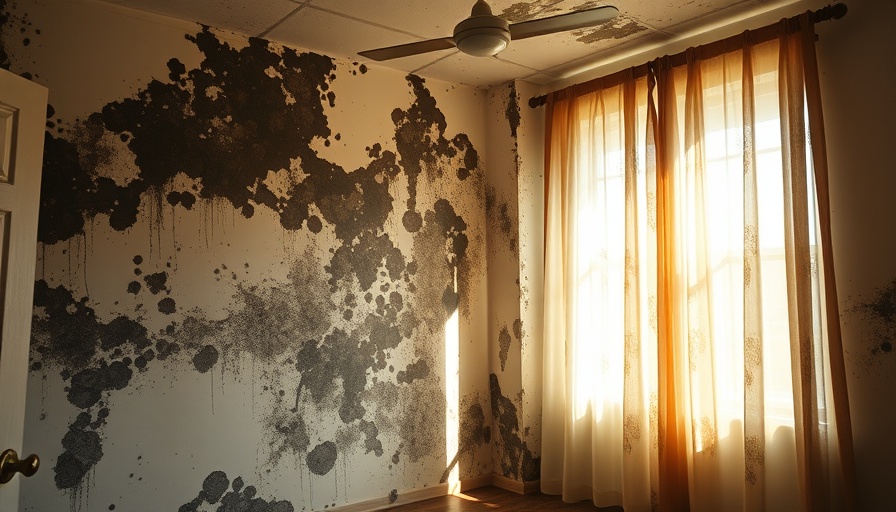
Unraveling the Mystery of Musty Odors
We've all experienced it: walking into our home only to be greeted by an unpleasant musty smell that lingers despite our best cleaning efforts. Though you might initially blame wet shoes or damp clothes, the real culprit could be hidden mold growth. Mold releases Microbial Volatile Organic Compounds (MVOCs), which emit that unmistakable musty odor. In our quest for clean air, understanding what fuels mold growth and how to mitigate its effects becomes crucial.
Why Mold Thrives in Our Homes
For mold to flourish, it requires specific conditions, namely moisture and warmth. Areas like bathrooms, kitchens, and basements are often damp and poorly ventilated, making them perfect breeding grounds for mold. According to experts, even trivial leaks or condensation can create an ideal environment for mold to grow. Hidden mold can lurk behind walls, within HVAC systems, or under flooring, allowing it to proliferate unnoticed.
The Health Risks of Mold Exposure
Beyond its unpleasant odor, mold poses significant health risks. Prolonged exposure can lead to respiratory issues like coughing and wheezing, as well as allergic reactions, headaches, and fatigue. For individuals with asthma or other respiratory conditions, inhaling mold spores can trigger severe symptoms. Understanding these risks emphasizes the need to address musty odors quickly and effectively.
Identifying the Source of Musty Smells
Effective mold removal starts with identifying the source of the musty smell. Inspect areas prone to moisture accumulation, like:
- Bathrooms: Mold thrives in the warm and humid conditions here, often found in grout, around fixtures, and in shower curtains.
- Basements: Dampness and poor ventilation make these areas common hideouts for mold.
- HVAC Systems: Mold spores can accumulate in ducts and vents, circulating foul odors throughout your home.
In addition to these areas, common household items like damp laundry or wet shoes should be inspected, as they can also contribute to that musty smell.
Strategies for Eradicating the Musty Odor
Removing musty odors goes beyond surface cleaning; it requires a systematic approach to eliminate mold at its source. Here are some steps:
- Fix leaks: Repair any plumbing or roof leaks immediately to prevent mold from gaining a foothold.
- Improve ventilation: Ensure your home is well-ventilated, particularly in moisture-prone areas. Consider using exhaust fans, air purifiers, and dehumidifiers to reduce humidity levels.
- Regular inspections: Schedule routine checks of hidden mold hotspots such as attics, crawl spaces, and behind walls.
- Professional help: For significant mold infestations or persistent odors, consult mold remediation companies that specialize in detection and removal. They can provide advanced testing and remediation services tailored to your home’s specific needs.
Long-Term Prevention Tips
Preventing musty smells and mold growth is an ongoing effort. Implementing the following strategies can keep your home healthy:
- Use natural deodorizers: Ingredients like baking soda and vinegar can absorb musty smells. Placing bowls of these in affected areas can provide relief.
- Maintain proper humidity levels: Aim to keep humidity levels below 60% with the help of vent fans and dehumidifiers.
- Regular cleaning: Cleaning your home regularly, particularly in high-moisture areas, will help prevent mold from becoming a problem.
Awareness and vigilance are key to maintaining mold-free living spaces. It’s vital to keep an eye on moisture levels and act swiftly at the first signs of mustiness. By doing so, you can protect not only the integrity of your home but also your family's health.
Take Action Today!
If you're tired of battling musty odors or suspect hidden mold in your home, don’t wait for the problem to escalate. Contact professional mold remediation services to ensure your living space is clean and healthy. Companies offering mold inspection and testing can provide peace of mind and restore your home's air quality swiftly.
 Add Row
Add Row  Add
Add 




 Add Row
Add Row  Add
Add 


Write A Comment